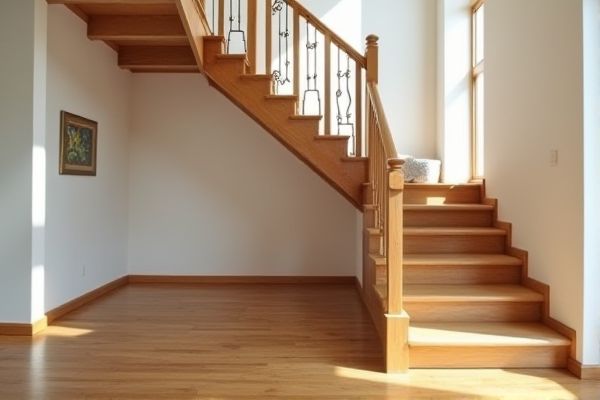
Softwood staircases offer affordability and easier customization, while hardwood staircases provide unmatched durability and classic elegance. Discover which option suits your home's style and longevity needs by reading the rest of the article.
Table of Comparison
| Feature | Softwood Staircase | Hardwood Staircase |
|---|---|---|
| Wood Type | Coniferous, e.g., pine, fir | Deciduous, e.g., oak, maple |
| Durability | Moderate, prone to dents | High, resistant to wear and tear |
| Cost | Lower, budget-friendly | Higher, premium price |
| Weight | Lighter, easier installation | Heavier, sturdier feel |
| Grain & Appearance | Softer grain, rustic look | Distinct grain, elegant finish |
| Maintenance | Requires regular sealing/painting | Less frequent maintenance needed |
| Lifespan | 10-20 years | 20+ years |
| Environmental Impact | Fast-growing, more sustainable | Slower growth, less sustainable |
Introduction to Softwood vs Hardwood Staircases
Softwood staircases, typically made from pine, fir, or spruce, offer affordability, ease of installation, and a light, natural appearance ideal for casual or rustic interiors. Hardwood staircases, crafted from oak, maple, or cherry, provide superior durability, resistance to wear, and a rich aesthetic that enhances formal or traditional home designs. Choosing between softwood and hardwood depends on budget, desired longevity, and style preferences, with hardwoods generally preferred for high-traffic areas due to their strength.
Key Differences Between Softwood and Hardwood
Softwood staircases are typically made from pine, fir, or cedar, offering affordability and easier workability, making them ideal for budget-focused or decorative projects. Hardwood staircases, constructed from oak, maple, or mahogany, provide superior durability, density, and resistance to wear, ensuring long-lasting performance in high-traffic areas. The choice between softwood and hardwood staircases impacts maintenance requirements, lifespan, and overall aesthetic appeal, influencing the staircase's functionality and style.
Durability and Longevity Comparison
Hardwood staircases, such as oak and maple, offer superior durability and longevity due to their dense grain structure, making them resistant to dents, scratches, and wear over time. Softwood staircases, like pine and cedar, are generally less durable and more prone to damage but can still provide satisfactory performance in low-traffic areas. Choosing hardwood ensures a longer-lasting staircase that maintains structural integrity and aesthetic appeal for decades.
Aesthetic Appeal and Design Versatility
Softwood staircases offer a warm, rustic aesthetic with visible grain patterns that complement traditional and country-style interiors, while hardwood staircases provide a sleek, refined appearance, enhancing both modern and classic designs. Hardwood varieties like oak, maple, and cherry grant greater design versatility due to their hardness, durability, and ability to accept various stains and finishes without damage. Softwoods such as pine or cedar are easier to carve, allowing for intricate custom designs but may require more maintenance to preserve their beauty over time.
Cost Analysis: Softwood vs Hardwood Staircases
Softwood staircases generally cost less upfront due to the faster growth rate and abundance of materials like pine and spruce, making them a budget-friendly option for your home. Hardwood staircases, crafted from denser woods such as oak, maple, or mahogany, tend to be more expensive but offer superior durability, longevity, and aesthetic appeal, justifying the higher investment. Considering maintenance and potential refinishing costs can also influence the overall cost analysis, as hardwood often requires less frequent repairs compared to softer wood varieties.
Installation and Maintenance Considerations
Softwood staircases offer easier installation due to their lighter weight and more workable texture, making them ideal for DIY projects and quicker assembly. Hardwood staircases require professional installation because of their density and weight, ensuring durability and precise fitting, but they demand less frequent maintenance over time. Regular care for softwood includes sealing and protecting against dents, whereas hardwood requires periodic polishing to maintain its rich finish and resistance to wear.
Environmental Impact and Sustainability
Hardwood staircases typically come from slower-growing trees, making their sourcing less sustainable and contributing to deforestation concerns, whereas softwood staircases are often made from faster-growing species, allowing for more renewable and eco-friendly harvesting practices. Softwood tends to have a lighter carbon footprint due to quicker replenishment rates and efficient plantation management, which can make your choice more environmentally responsible. Evaluating certifications like FSC can help ensure that your staircase aligns with sustainable forestry practices.
Slip Resistance and Safety Features
Softwood staircases typically offer better slip resistance due to their softer, more textured surface, reducing the risk of accidents in your home. Hardwood stairs, while durable and aesthetically pleasing, often require additional treatments or non-slip coatings to enhance safety. Choosing the right material for your staircase involves balancing durability with safety features to protect every step you take.
Popular Wood Species for Staircases
Popular softwood species for staircases include pine, cedar, and fir, known for their affordability, ease of working, and lighter hues that complement modern interiors. Hardwood staircases often feature oak, maple, cherry, and walnut, prized for their durability, rich grain patterns, and ability to withstand high traffic. Selecting the right wood species depends on desired aesthetics, budget, and staircase usage intensity.
Choosing the Right Material for Your Staircase
Softwood staircases offer affordability and ease of installation, making them ideal for budget-conscious projects or DIY enthusiasts. Hardwood staircases provide superior durability, intricate grain patterns, and long-lasting beauty, perfect for high-traffic areas or luxury homes. Choosing the right material for your staircase depends on factors like budget, aesthetic preferences, and expected wear, ensuring your stairs complement your home's design while standing the test of time.
 homyna.com
homyna.com